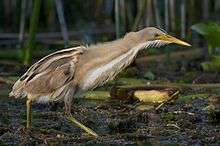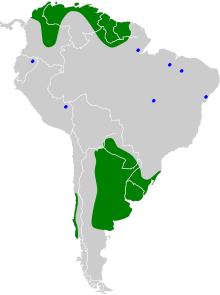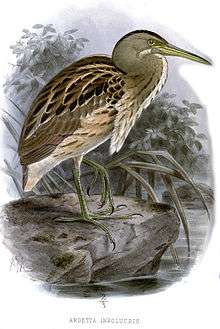Stripe-backed bittern
The stripe-backed bittern (Ixobrychus involucris) is a species of heron in the family Ardeidae which is found in South America and Trinidad.
| Stripe-backed bittern | |
|---|---|
 | |
| Scientific classification | |
| Kingdom: | Animalia |
| Phylum: | Chordata |
| Class: | Aves |
| Order: | Pelecaniformes |
| Family: | Ardeidae |
| Genus: | Ixobrychus |
| Species: | I. involucris |
| Binomial name | |
| Ixobrychus involucris (Vieillot, 1823) | |
 | |
Description

The stripe-backed bittern is very small, averaging around 30 cm (12 in) in length. It is darker brown with a white and brown striped pattern along the back, and a black stripe from head to tail, while the underbelly is lighter brown and striped with white. This bittern calls through distinct, low-pitched 'ooks', or through gargling.
Distribution and habitat
The stripe-backed bittern is distributed in large patches across South America, located in Colombia, Venezuela, Guyana, Suriname, French Guiana and the island of Trinidad to the north, and in Paraguay, Uruguay, Argentina, Chile and Brazil to the south,[1] inhabiting reed-beds and sedge.
Behaviour and ecology
The stripe-backed bittern is a solitary animal. It generally feeds at night on small fish, crustaceans and insects such as dragonflies and water beetles. It is not a strong flier, and only does so across short distances. When threatened, it responds by pointing its neck and bill skyward, a characteristic posture of bitterns.
The stripe-backed bittern makes small nests of reeds and stems, which are found above water level, among reeds. The clutch consists of three eggs. Incubation period for eggs is unknown, and breeding seasons appear to vary based on location.
Status
This bittern is considered to be of least concern due to its wide range, and large, stable population.
References
- BirdLife International (2012). "Ixobrychus involucris". IUCN Red List of Threatened Species. 2012. Retrieved 26 November 2013.CS1 maint: ref=harv (link)
- ffrench, Richard (1991). A Guide to the Birds of Trinidad and Tobago (2nd ed.). Comstock Publishing. ISBN 0-8014-9792-2.
- Junge, G.C.A.; Mees, G.F. (1961). Avifauna of Trinidad and Tobago. E.J. Brill.
- Kushlan, James A.; Hancock, James A. (2005). Herons. Oxford University Press. ISBN 0-19-854981-4.
- Martínez-Vilalta, A.; Motis, A.; Kirwan, G.M. (2014). "Stripe-backed Bittern (Ixobrychus involucris)". Handbook of the Birds of the World Alive. Lynx Edicions. Retrieved 24 February 2015.
- "Ixobrychus involucris". Cornell Lab of Ornithology. Retrieved 24 February 2015.
